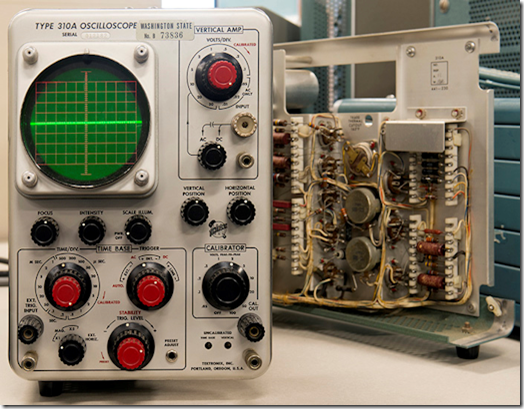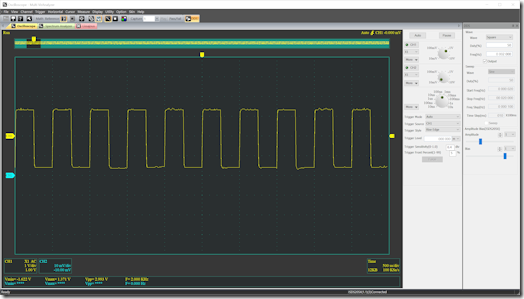
Many moons ago, I got hold of an oscilloscope from an army surplus depot. It was a pretty decent machine – a Tektronix – albeit very basic and dated. I haven’t used it in donkey’s years, and although it is still in the garage, I wouldn’t dare turn it on now. It was one of the old CRT jobs, and they had high voltages inside, so with the damp and all that… too risky. It only cost me about £50, but a new one would have been several hundred, so it was a good deal at the time. Like the old TV sets, it weighed an absolute ton, mainly due to the massive transformer and valve chassis inside.
I’ve got a project on the go at the moment which involves an audio circuit – basically, a microphone input and a line-level output. I need to check the frequency characteristics of the circuit to make sure there’s no signal dropout (and to be able to quote this for the final product), so I was suddenly looking for an oscilloscope and a signal generator.
Over the last few years, I’ve bought quite a bit of stuff from AliExpress. Consider this: if you wanted to buy, for example, a strip of 5050 LEDs (60 LEDs per metre, IP20), you’d be looking at paying at least £12 for a 5m reel in the UK – probably with shipping on top of that. You can buy the same from sellers on AliExpress for about £3.50 with free shipping. This price differential applies to virtually everything on there. You usually don’t pay any import duty, and even if you do it isn’t much. The only negative is how long things can take to arrive. Sometimes they come in less than a fortnight, other times (though rarely) it can take two months. Most shipments are tracked, and suppliers bend over backwards to help, and will replace lost or faulty items without quibble.
With that in mind, I hopped on over to the AliExpress website to see if they had any handheld oscilloscopes. I almost drowned in my own drool when I saw what they had. You can get “pocket” oscilloscopes the size a smartphone for not much more than $100, and many include a signal generator built in. I’d earmarked one of these, but then I discovered the Instrustar ISDS205X Virtual PC USB oscilloscope. It has a signal generator and logic analyser and seemed too good to be true. I asked the supplier if it was Windows 10-compatible – it was – and duly placed an order.
It took about two weeks to arrive (nearly one of those weeks stuck at Heathrow customs judging from the tracking data, and the fact I did have to pay import duty of about £12 on its £70 selling price).
 The oscilloscope consists of the main module, housed in a 160 x 110 x 28mm metal case with rubber endcaps, and a collection of probes and cables – plus the all-important software on a mini-DVD. The instructions on the DVD are typical Chinese-English material, but since I am not a Brexiter I can work around that and see things for what they are rather than demanding an immediate bonfire to burn things I don’t like. So, I installed the drivers and plugged the oscilloscope into my PC. It is powered by the USB port, so no separate PSU is needed.
The oscilloscope consists of the main module, housed in a 160 x 110 x 28mm metal case with rubber endcaps, and a collection of probes and cables – plus the all-important software on a mini-DVD. The instructions on the DVD are typical Chinese-English material, but since I am not a Brexiter I can work around that and see things for what they are rather than demanding an immediate bonfire to burn things I don’t like. So, I installed the drivers and plugged the oscilloscope into my PC. It is powered by the USB port, so no separate PSU is needed.
I wasn’t expecting much from the software, and all I wanted was for it to work. To say that I was pleasantly surprised is a huge understatement. The software is very smart-looking.
 Whenever you run it you have a choice between “professional” and “simplified” and various other displays. The snapshot, above, is of the simplified one showing a 2kHz square wave produced by the internal signal generator being monitored on Channel 1. If you click the image, you can see the display in more detail.
Whenever you run it you have a choice between “professional” and “simplified” and various other displays. The snapshot, above, is of the simplified one showing a 2kHz square wave produced by the internal signal generator being monitored on Channel 1. If you click the image, you can see the display in more detail.
I’m running it on a Windows 10 machine with a 4k display, and it works perfectly. I haven’t got to grips with all the functions yet, but you can save data – so it is also a logger. A further huge bonus is that the signal generator has a “sweep” mode, so I can set it to start at 20Hz and go up in increments of maybe 100Hz (or whatever I choose) to 20kHz and save the data. This means I can connect the signal generator output to my circuit input, attach the oscilloscope to the output (one channel per stereo channel), set it to “sweep”, and record the results. A feature I think it might also have is that I can mathematically compare the input and outputs and get a difference (even if it doesn’t, a spreadsheet will do that for me).
I doubt that I will ever use the full range of features, but at least I have everything I need for my latest project.